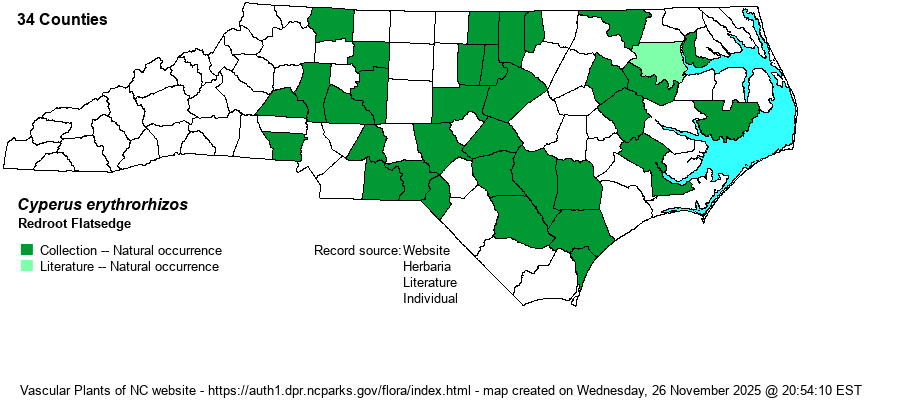| Author | Muhlenberg | |
| Distribution | Piedmont and Coastal Plain. The gaps shown on the map are likely to be filled in with additional fieldwork. Not found in the Mountains or most Piedmont foothills.
ME to southern Sask. and WA, south to FL, TX, and CA. | |
| Abundance | Uncommon to frequent in both the Piedmont and Coastal Plain. The State Rank is recommended to be S4, instead of "S3?". | |
| Habitat | Wet backwaters and old channels of rivers, riverside marshes, beaver ponds, exposed mudflats. | |
| Phenology | Flowering and fruiting July-October. | |
| Identification | The red or orange-red roots of Redroot Flatsedge are a valuable clue. Stems are 1-2.5 feet tall, with several long, leafy bracts at the summit, overtopped by the branched inflorescence. The spikelets are a deep, golden brown color, each scale with a pale green center stripe. Cyperus strigosus may look similar, especially when not mature, but it lacks red color to roots and the spikelets are straw color or pale yellow-brownish. | |
| Taxonomic Comments | None
The genus Cyperus is mostly tropical and warm-temperate in distribution; thus, in NC it is much commoner in the Coastal Plain than in the Mountains and Piedmont. Most species have 1-few flowering stems (culms) from grasslike basal leaves, plus a few stem leaves. At the summit is an inflorescence of very open and branched, or tightly packed, spikes, varying among species from brown to golden brown to straw-color to reddish. The arrangement of the spikelets is important, whether like a hand (digitate) or in paired or alternate rows (pinnate); as is the shape of the achene (seed), whether bi-convex in cross-section or triangular. As a group, Cyperus tends to be weedy and readily enters disturbed ground; this is true for many natives as well as all the aliens. In recent years, following DNA research, the genus has incorporated several genera that in RAB (1968) or other manuals were separate: Hemicarpha, Lipocarpha, and Kyllinga. | |
| Other Common Name(s) | None | |
| State Rank | S3? [S4] | |
| Global Rank | G5 | |
| State Status | | |
| US Status | | |
| USACE-agcp | OBL link |
| USACE-emp | FACW link |

